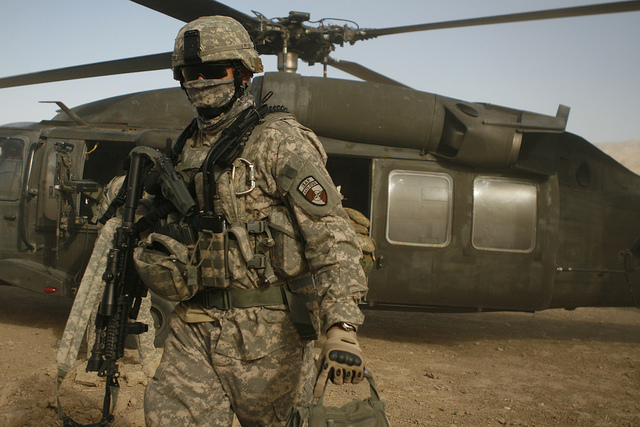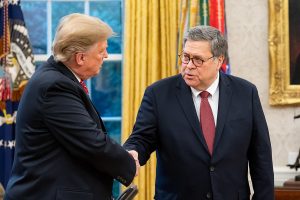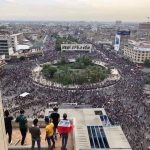By Lawrence Wilkerson
On Saturday, October 19 at the College of William and Mary, where I teach, the student veterans group convened “on the green” for a military style breakfast for themselves and military veteran alumnae. The event was well attended—even a veteran of the Korean War was present.
I’ll be 75 in January and I served 31 of those years in the military, so I’ve seen a lot of military veterans. As the faculty advisor to student veterans at William and Mary, I’ve also seen quite a few of the current batch.
For the most part, lean and soft-spoken, full of energy and drive, men and increasingly women, most wanting to get on with their now-civilian lives but pausing momentarily to acquire that education everyone has advised them is almost essential to success, they lean into the hours just like I’m confident they leaned into their wars.
This group is very diverse in its Service affiliation: for the second year in a row, we have a Marine student president of the group, and among the membership, several Army types, an older Coast Guard gentleman who owns his own business, a doctoral candidate from the Navy as well as several other sailors, and a semi-permanent W&M resident, it seems, in a USAF veteran pursuing two advanced degrees. And this group is separate from the thriving veterans groups in the on-campus Law School and the Mason Business School.
With a current veteran suicide rate that is truly tragic and high percentages of post-traumatic stress and brain injury among the ranks, our campus is somewhat like an oasis when one contemplates the “desert” that often surrounds it. Yet none of these young men or women ever forgets how fortunate they are to have “come through” and to be where they are. It’s very safe to say that they would bring any one of their battle buddies to the campus if they could, and she or he could qualify academically.
At the recent breakfast, the comfortable nature of the way the older veterans blended with the younger and middle range veterans was a bit amazing, the camaraderie of shared sacrifice the only glue necessary. I wish it were as easy with the non-veteran students.
With them, there is a wariness on both sides. The veterans, usually several years older and normally far more mature, doubt the seriousness of the non-veterans. The younger students aren’t quite sure what to make of the veterans, so most shy away. That’s fine with most veterans who are not interested in casual conversation anyway. When both sides do manage a meaningful conversation—if they can get around the fact they often speak a different language—relationships can and are created, but they seem a bit hollow and ephemeral usually.
For people who have never risked their lives for their country and even more so when they know that less than one percent of America’s youth has in fact done just that, and a couple of them are standing right there, it makes it difficult to mix and mingle. To some non-veteran students’ credit, they nonetheless try. Sometimes lasting relationships are thus created; but not very often.
Scholars of national security affairs label this situation part of “the civil-military divide.” It’s a very dangerous schism for a country such as America. However, it’s virtually inevitable when a prolonged period of sacrifice (18 years of war and counting) calls on only a few to bear that sacrifice and leaves the vast many free to do whatever they please with no obligation to service. It matters little to the military veterans that some of these young people do in fact do public service—in the Peace Corps, in the Foreign Service or other professional government service organizations—because these are not lethal services, i.e., their members do not normally and routinely go in harm’s way.
What troubles us older veterans today—or at least some of us—is that there is absolutely no sign of America’s leadership recognizing the reality and danger of this divide. Yet its parameters are becoming so well-defined that one could quite accurately speak of a caste system developing in America with the non-serving on one side and the serving on the other.
Moreover, the current leadership in the White House seems determined to make matters worse. For example, at the same time it heralds its disastrously-managed “withdrawal” from Syria, the Administration deploys more troops to Saudi Arabia, tightens what is already an economic blockade of Iran, falters dangerously in its pseudo diplomacy with North Korea, and flirts idiotically with engaging half a dozen other powers, from Turkey to Russia, in “a little shooting war” of its own design. One can argue that this is just Trump being Trump, but other world leaders might not see it that way.
For example, the President said recently that, “I’m trying to get out of wars. But we may have to get in wars, too. OK? We may have to get in wars. … We’re better prepared than we’ve ever been. If Iran does something, they’ll be hit like they’ve never been hit before. I mean, we have things that we’re looking at.”
This presidential unpredictability is a sour note to all in the U.S. military. They know that it is they who will be doing the hitting.
In short, while President Trump says he is against stupid, endless wars, his actions betray an altogether different national security posture. So, while one could argue that the best way to smooth over this civil-military divide is to end the imperial wars, such an end appears nowhere in sight.
If such a future of endless war, for whatever reason, is indeed more or less a reality, then the only other way to deal successfully with this dangerous development is to spread the burden of service more equitably.
Indirectly, Washington has recognized this—if for no other reason than the staggering current and future cost of populating the military—and a little over a year ago established the Commission on National, Public, and Military Service, whose interim report came out in March of this year.
The snake in this grass, however, is that the Commission is not going to recommend a return to conscription, the least expensive and most expeditious solution to the problem. Its most likely recommendation will be to encourage strongly voluntary national service. This will do very little if anything for the lethal service of the military because most young people, no matter how strongly encouraged to pick a military service, will not. The entire idea of voluntary national service, while a laudable goal, changes nothing really at the end of the day. For the military, it is a political cop-out.
A few Americans are following these issues and are deeply concerned about both the country and its military. The members of the All-Volunteer Force Forum, established in 2016, are among such Americans and, as one might imagine, most of the members, but not all, are military veterans.
The Forum has convened conferences to initiate debate and discussion on these critical matters at Kansas University (2016), my own school William and Mary (2017), the Ohio State University (2018), and Angelo State University in San Angelo, Texas (2019). A conference in March, 2020 will be held at the Catholic University in Washington, DC. Moreover, a panel discussion will be held on November 19 this year in the U.S. Senate, facilitated by Senator Sherrod Brown (D-OH).
This debate needs badly to heat up. It also needs leadership participants, i.e., from the states, from the Congress, and from the White House. This is too vital an issue to be ignored any longer. The fiscal aspects alone of maintaining the current military are daunting.
For example, at present rates of increase, the military budget—better than 50 percent of which is paying for the very expensive population of the All-volunteer force—combined with the annual interest payments on the U.S. aggregate debt of $22-plus trillion, will negate any other discretionary Federal spending by the end of the coming decade.
Yes, that is correct: no money will remain for anything else discretionary. Fixed costs alone will exhaust the annual Federal Budget. The math is inescapable.
Add to this very serious fiscal situation the ethical, moral, efficiency, and fairness issues only touched upon briefly above, and the nation confronts yet another profound challenge at a moment in its and the world’s history that seems replete with such challenges, from the resurgence of nuclear weapons to the climate crisis.
But that is no provocation to put our heads in the sand and ignore this particular challenge; yet, that is what American leadership and the American people seem powerfully inclined to do.
As with the other challenges, we need the people in this democracy to arouse themselves. There are innovative, fair, efficient and far less expensive ways to populate the military. People need to begin thinking about such ways and promoting them.
For instance, one of the components of our military suffering serious injury is its reserves—the National Guards in the Army and Air Force and the Reserves in the Army, Navy, Air Force, Marine Corps and Coast Guard.
Since our very beginnings as a nation, the “Reserves” have been a strategic force. The National Guards (state militias) were called up and federalized only in national emergencies, as the Constitution allows. The various Service reserves, in different configurations ranging from the Individual Ready Reserve (IRR) to what is generally referred to as the Active Reserve (training more often), fulfilled a mobilization mission in case of “the big one,” as we used to say in the Army.
For the past two decades, however, members of these parts of the military have been called to Active Duty on average about every four years, sometimes as individuals but often as entire units. Such volatility in reservists’ lives plays havoc with their civilian careers and with their civilian employers’ businesses. Why does Microsoft, for example, want to hire a woman or man who will be gone for a year or more every four years? No, Microsoft would much rather hire someone who will be around all the time. And that is totally understandable in today’s highly competitive business environment.
A creative way to ameliorate this very bad situation would be to have an annual draft—run by a lottery as fair as humanly possible, i.e., no exceptions whatsoever if health and intellect measure up—to put men and women into the Reserves. National Merit Scholars and potential NFL linebackers as well as poor kids from West Virginia and Alabama would then be funneled into the military, spreading the burden and sharing the risks as well as better socializing America’s youth.
Once these young men and women were inducted and trained, they would have a menu of choices. For instance, if they are called to active duty and deployed at any point in their six-year commitment, they could leave the military at the end of the deployment if they so chose. Their service would be complete.
If however they discovered a niche for themselves on active duty, they could stay and be a member of the active forces for whatever time they and the Service desired. Moreover, they would be eligible to apply for commissioned officer training and status either through Officer Candidate School or, if they could gain admission to university, as a member of the Reserve Officer Training Corps (ROTC). Of course, they could also choose to return to their unit in the Reserves and finish out or continue their service there.
Such an innovative, creative approach to populating the Reserves would stabilize and rejuvenate them, make civilian employers happy, and create a new pool of high-quality candidates for the active military.
And this is just one of the possibilities for better managing the way America populates her military. There are several others. But if no one is courageous enough to begin exploring them, we will gain nothing.
“Nothing will come of nothing…”, Shakespeare’s King Lear exclaims to his daughter Cordelia at the play’s beginning. And Lear is right, but only to a point. Anyone familiar with that drama knows full well what fate awaits both Lear and Cordelia, and it is far worse than “nothing.” It is the death of both the king and his beloved daughter.
Such darkness might be America’s fate if nothing is done about how the country manages its military.
Lawrence Wilkerson served 31 years in the U.S. Army, retiring as a colonel. He is the Distinguished Visiting Professor of Government and Public Policy at the College of William & Mary.






I’m aghast as I read this article, particularly the statement that ‘if such a future of endless war, for whatever reason, is indeed more or less a reality, then the only other way to deal successfully with this dangerous development is to spread the burden of service more equitably.’
How is it possible that an intelligent veteran and professor would accept endless wars as ‘more or less a reality’. Why would Professor Wilkerson not fight with every strand of his being to end the economic and political enablers of endless war. Professor Wilkerson and all veterans know all too well the hate and death that comes out of war. That nothing positive has ever been accomplished by war. And that war is the ultimate failure of politicians, leaders and statesmen. A failure that these same people then send young men and women to their deaths to make up for.
On Remembrance day (Veterans day in the US), let’s never forget the ultimate sacrifice that those before us were forced make. Let’s never forget or forgive those who failed those young men and women and sent them to their deaths. And let’s work ensure that young men and women are never asked to make this sacrifice again.
I am a veteran of 27 months combat duty in Viet Nam. I have generally been quite respectful of Prof. Wilkerson’s writings. However, this article shocks me.
First we are treated to a myopic view of veteran-civilian relations that ignores the very substantial number of veterans like myself who don’t want to rub elbows with other veterans, who dove back into society rather than viewing ourselves as outsiders because of our government exposure to violence. Those veterans who want to hang out with other vets generally have a war hawkish, flag-waving view of themselves as “patriots” that is in fact quite nauseating to those who have not fallen for the “vets are all heroes” prattle that government propagandists incessantly try to stuff down our throats.
In fact, most veterans are, understandably, anti-war. The Military Times reported on July 10: “In a survey of nearly 1,300 veterans conducted in May and June, 64 percent of those surveyed said the war in Iraq was not worth fighting, as opposed to just 33 percent who said the security benefits outweighed the sacrifices. For Afghanistan, 58 percent of veterans said that fight was not worthwhile, versus 38 percent who believed it was.”
So let’s be clear, veterans are not nearly as homogenous a group as Prof. Wilkerson describes.
Next we are told that by the end of the next decade, there will be no federal budget left for anything but Defense spending. But nonetheless, we should all worry that the military won’t be able to recruit enough troops to spend all that money, so we should institute a new method of drafting troops into the Reserves to feed fresh bodies to the active duty military maw. And somehow, this is going to please our oligarchs, apparently because they will know not to hire anyone who is draftable or already in the reserves.
In closing, Prof. Wilkerson admonishes that we need to get serious about finding new ways to put more young people in uniform, else there be dire consequences.
But what are those dire consequences in reality beyond the fact that our military needs drastic downsizing and a return to defending this nation rather than maintaining and expanding the American Empire overseas? Because of our geographic location and our stable of nuclear weapons, in reality we need not worry about being attacked by another military power. And we learned on 9-11-2001 that our conventional military forces were incapable of defending us from terrorist attack. And despite our military’s very considerable efforts in the Middle East, al Qaeda now has tens of thousands more members than it did on 9-11.
Our military has not won a contested war since we defeated the Japanese in World War II. But it has shown itself perfectly capable of causing some 20-30 million deaths in other nations since then. And despite a long series of illegal U.S. wars of aggression, not a single flag officer in the U.S. military has refused to carry out illegal orders to invade other nations. They uniformly suffer from moral cowardice.
What is needed is to get the heel of the oligarchs off the American public’s necks. House Joint Resolution 48 has 65 co-sponsors and unlike the proposed constitutional amendment being pushed by Democratic Party elites will get all money out of election and ballot measure politics. And with the money out of politics, the military-industrial complex will wither back to what is actually needed to defend this nation.
I must agree with Asif’s comment-why assume the continuing, wasteful, destructive history of the USA as an invader and destroyer of countries all over the globe, coupled with “sanctions”, bribes,overthrowing of elected governments, interference with cooperative movements like the Chinese-led BRI, just to ensure the USA remains “top dog” for ever?
“Defense” is a mockery of the term- enough people actually to defend the USA from its possible enemies (increasing in number because of the USA’s attacks, but hardly likely to invade!) would be comparatively easy to find among 320 million humans if some sense were to be brought into the equation.
Rosemary,
Agee with you. The HB “AUTHORIZATION FOR USE OF FORCE” or (AUMF) approved by the House in 2001 has been misused and abused by the ”Polastitutes” ever since. The Bill should repealed by the House. Henceforth, every aggression must be debated and funded if approved as it used to be, although that didn’t work for the Vietnam war! Also the department of defense should be renamed as the department of offense to match its past behavior.
Colonel Wilkinson,
Perhaps one more major change needs to occur in the US. It is time for changing the decision making process for the arm forces from 1person show ,the President, to a group of people. The responsibility and the decision making about any war should fall on a group of people like, President, VP, the head of Senate, speaker of the House, Sec of State, sec of “Offense” collectively chaired by the President who also retains his or her “commander in chief” title as stated in the US Constitution.